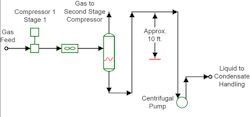A top-notch piping designer was asked to train a group of process engineers after a revamp hadn’t gone well. He bluntly counseled them that complaints “only a fool would do piping like that” probably are misdirected — the engineer often is at fault for not understanding what the piping designer needed to know.
A recent review of a project involving a compressor train, with cooling and liquid knockout between the stages, highlighted this issue (see Figure 1). After the cooler, a knockout drum removes liquid condensate. The condensate then is pumped to a different part of the unit for further processing. The piping from the bottom of the knockout drum goes up through an inverted-U loop. The top of the loop is a high point ten feet above the liquid level in the drum. The end side of the inverted U drops straight into the suction nozzle of a horizontal pump. The horizontal pump uses a between-bearings shaft and has both the suction and the discharge nozzles pointed upwards.
At first glance, the piping layout looks horrifying — and at second glance, too. The liquid in the drum is near its bubble point. As long as there’s enough static head of liquid in the system, this head provides pressure for flow out the bottom nozzle and along the pipe without vaporization.
As the liquid rises along the upward side of the inverted U, the pressure of the liquid drops until it reaches its bubble point. Then, the liquid starts to vaporize. A vapor pocket forms in the top of the inverted U. Liquid flow stops.
If the pump is running, it can “suck” some vapor out of the feed pipe, reducing the pressure. This may create enough suction lift to get flow over the top of the inverted U. However, the flow to the pump always will be two phase. The lower pressure drawn by the pump suction causes vaporization. This is an extreme case of what happens when a pump has vaporization due to insufficient net positive suction head.
[pullquote]
Two situations might make this system “work” — but not well. The first is if the system has enough heat loss in the piping that the liquid entering the piping is subcooled. For this application, that’s unlikely because it would require approximately 7°F of subcooling. At the flow rates involved, the surface area of the pipe simply won’t lose enough heat to the environment, even on a very cold day. The second is if there’s enough vaporization and velocity in the upward line; then, it might be possible for liquid to get to the top of the inverted U and fall down the other side with the vapor being recompressed and condensing. I’ve never seen this happen in practice. However, a colleague swears he’s seen such a system. Unfortunately, that system had to have exactly the right flow rate to work and had significant damage to both the pump and the piping.
Figure 1. The piping's 10-ft-high inverted U promised to undermine reliability.
Some questioning clarified the reasons for the strange piping layout. The piping designer was using a standard that required a minimum of 15 diameters of straight pipe at the pump suction inlet. By itself, this is good practice. It makes for smoother inlet flow into the pump and more-reliable pump operation. However, the upward-facing suction nozzle meant the 15 inlet diameters were straight up. Combining the entry pipe requirement with the already selected equipment elevations and layout forced the creation of the inverted U. What the piping designer didn’t understand was that the line from the drum to the pump suction had to have no pockets. (For more on this, see: “Piping Geometry: Grasp Line Layout.”)
Here, reliable plant operation demands a change in piping layout. The most straightforward solution is to switch to a pump with a side suction nozzle. Unfortunately, the pump already had been purchased. Nevertheless, the economic penalty incurred from changing the pump order clearly is the cheapest option over the long term.
This episode points up the importance of team members helping each other understand what’s important in locating and piping equipment. Experience accumulates over time. Even the best of us has to start somewhere.




